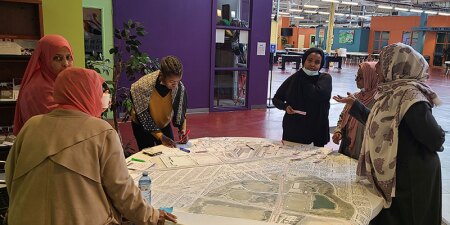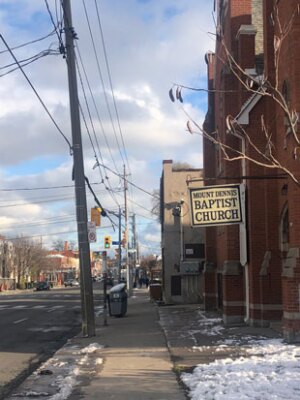Over the past 18 months, ULI Toronto and partners forged an understanding of the trends, pressures, and challenges experienced by Toronto’s Black population to shine a light on how history is shaping the present. The team documented Black displacement and Black settlement patterns in the Toronto area, focusing on the Mount Dennis neighborhood, which has faced disinvestment.
The perspectives and priorities of Mount Dennis residents were gathered to inform development priorities and future projects.
Team members say the efforts of ULI Toronto have led to:
- Workshops with residents in the Mount Dennis neighborhood created a replicable model for productive and safe discussions with community members affected by the rapid change happening in the neighborhood.
- Amplification of the perspectives of the local community in development decisions that will affect them.
- New and strengthened partnerships with local agencies, such as the Learning Enrichment Foundation,a nonprofit with social enterprise emphasis, to build trust with the communities.
_____________________________________________________________________________________
By many accounts, Toronto, Canada is the most multicultural city in the world. More than 200 ethnic groups are represented amongst the more than three million residents who call Toronto home, and 4.3 percent of residents identify as Black, per the 2021 Canadian Census. Although many may consider Canada to be a model of multiculturalism, Canada, in fact, has a long history of colonialism. Deep and systemic structural racism continues to permeate all facets of life across Toronto.
To help document and build awareness around the legacy of this little-known history, ULI Toronto, in partnership with The Black Planning Project, embarked on an 18-month research project to track historical Black displacement in Toronto. The focus, the neighborhood of Mount Dennis, is one of the city’s most diverse areas and the primary entry point for Black individuals and families immigrating and starting new lives in Canada.
The ULI team set out to research and document historical Black settlement and displacement in the Toronto area. “We wanted to ask questions [about] what the legacy barriers are facing Black populations living in the city today, and what are the enduring impacts of these barriers on the population’s ability to survive and thrive in our city going forward,” says Abigail Moriah, founder of The Black Planning Project and chair of the ULI Toronto program.
Research Limitations
Documentation of Canada’s Black history is sparse. Thus, the team found its work challenging. Moriah says they were surprised by the lack of data available to help uncover historic population trends, including displacement data. In some instances, the team had to rely on anecdotal reported knowledge of the Underground Railroad—the network of routes and safe houses that enslaved people used when attempting to flee the United States centuries ago—to inform displacement data collection.
Canada has been home to a “North Star” myth; that the country was akin to a “promised land” for the newly freed people who were escaping oppression in the United States. In fact, Canada had its own slave trade, and many policies discriminated against those who were formerly enslaved. Like America’s discriminatory policies, redlining and exclusionary zoning were common practices in Canada up to the 1960s but with fewer historical records or data documenting it.
This history shaped the perspective from which Black people in Canada have been viewed for centuries and is still impacting society. Today, public policy reinforces discriminatory outcomes, according to Richard Joy, executive director of ULI Toronto.
“A lot of structural racism manifests as exclusionary zoning—minimum lot size requirements, minimum square footage requirements, prohibitions on multifamily homes, and limits on the height of buildings. This type of zoning is permitted under the guise of maintaining neighborhood character, but it has exclusionary effects,” Joy says.
The ULI team found that telling the history of Toronto’s Black population was more complex than they originally anticipated.
“It highlighted to us that this is an area of work that requires more conversation between planners and historians,” says Moriah. “[We have] a role to ensure that developers understand the historical context of the areas they develop in.”
Understanding Mount Dennis
To understand how these issues were touching down in a particular place, ULI Toronto and partners held up a magnifying glass to the area of Mount Dennis.
The Neighborhood Change Research Partnership was led by a team of researchers and has tracked the distribution of Black households in Toronto. This research found the majority of Toronto’s Black population lives in the northeast and northwest areas of the city, including Mount Dennis, which are underserved by reliable public transit and other amenities.
More recently, the coronavirus pandemic has exacerbated resident challenges—cost of living increases due to rising housing prices and inflation, and generally fewer resources at the municipal level to service the communities in need.
“Mount Dennis is a traditionally low-income, working class, diverse community with a significant BIPOC population,” Joy says. Mount Dennis was also chosen as an area to study due to the existence of a local nonprofit Learning Enrichment Foundation, or LEF, which was spearheading the development of a housing project. The organization was committed to involving the community.
Moriah said the ULI Toronto project team wanted to find out what was happening in the neighborhood and what people prioritize as most important to address. The team was interested in finding out how the neighbors observe changes that have come to the area, whether they see them as being positive or negative, and what they would like to see happen in the future.
Some residents communicated their need to feel not just seen but heard. They are interested in companies that build new projects that keep their community and their needs top of mind.
“People were saying: ‘we just want to be engaged,’” says Moriah. “They would say: ‘We want developers to come and talk with us, to hear what we have to say. To hear what we would like to see in our community and find ways of corroborating.’ They feel really left out of the process. Development is happening to them and around them, but they’re not engaged in that process.”
This viewpoint resonates with ULI Toronto team member Sally El Sayed. In the past, developers would seem to converge on the area without taking the time to build trust with the neighbors or realize how valuable their knowledge of the community was. “I think this is super important,” says El Sayed.
“To developers and nonprofits, what are opportunities to create those spaces for those real conversations to happen?” says Moriah.
In addition, there is a major transit investment happening in Mount Dennis that is making a significant impact on the landscape. The area has also seen an increase in other development projects.
“It’s getting a tsunami of real estate forces coming at it that are taking this very affordable lower-income neighborhood and turning it into one of the real estate hotspots of the city,” Joy says. “So that challenge is a living example of what’s happened in the past with very dire, negative consequences for the Black population.”
Community Engagement Best Practices
To address the needs of Mount Dennis, ULI Toronto recommends that real estate developers and leaders take these steps:
- Educate yourself about the community in the nascent stages of a development project via studying reports and data as well as building relationships with locals.
- Develop an understanding of what residents desire and need by attending events and working with nonprofits and community-based organizations.
- Build informal and formal bonds with local groups and consult with existing nonprofit and community-based forums, including Toronto Strong Neighborhoods Strategy Neighborhood Clusters, as one example.
- Allow residents to voice concerns throughout the development process and share information with them using counter-mapping and community-based design to gain feedback from locals.
- Invest in the community and illustrate examples of how Canadian developers merge community development and the community in development.
“Within Mount Dennis, there are a lot of Black homeowners, but there are Black renters as well, and we know from research that there are high levels of eviction filings, so there is a high potential of Black renters being evicted,” says Moriah. “So that was of concern, because if development is happening, and people are potentially at a higher risk of being evicted, then where are they going to live? Where do they move to?”
The ULI Toronto team got significant insight from neighbors by asking how they wanted to engage in development in the future. The team organized a community counter-mapping workshop and developed an ArcGIS counter-mapping website to ascertain the needs of locals.
“I think it kind of reinforced the importance of needing to engage with community, to learn about them at the onset of the development versus through background research and the need to find ways of integrating that information into the development process, so that development can be more responsive,” Moriah says.
Editor’s Note: ULI Toronto is one of five district councils participating in ULI’s District Council Partnerships for Health and Racial Equity Project led by ULI’s Building Healthy Places program with support from the Robert Wood Johnson Foundation. Working over 18 months, each council, in partnership with local stakeholders and real estate leaders, crafted strategies to address legacy impacts of systemic discrimination in land use and real estate. Learn more about the collective story of impact at uli.org/partnerships.








